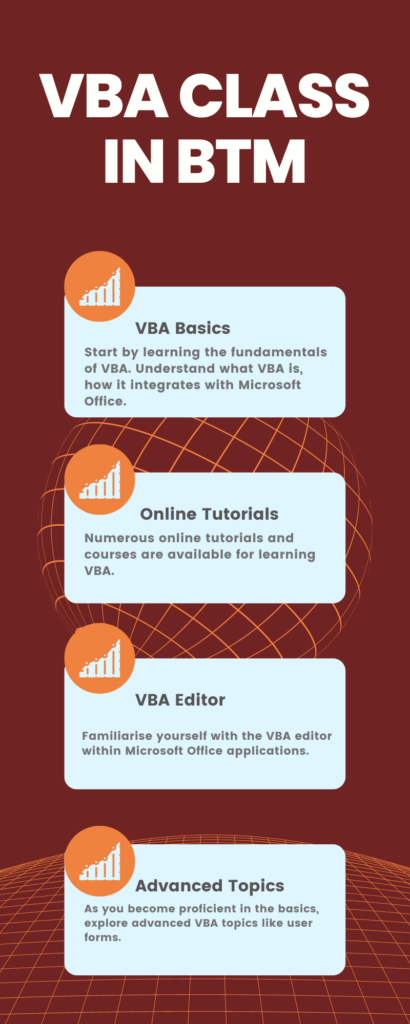

Best VBA Classes in BTM, or Visual Basic for Applications, is a programming language developed by Microsoft. It’s primarily used for automating tasks and building custom solutions within Microsoft Office applications like Excel, Word, PowerPoint, and Access. If you’re interested in Best VBA Classes in BTM, here’s a detailed explanation of what it entails:
VBA is a versatile language that can greatly increase your efficiency and productivity when working with Microsoft Office applications. It’s widely used in business and data analysis roles and is a valuable skill for professionals in various fields. Continuous practice and exploration of new VBA techniques will help you become a proficient VBA developer.
In today’s data-driven world, Excel remains a go-to tool for businesses and professionals across various industries. Its versatility and vast range of functions make it a favorite for data analysis, reporting, and visualization. However, to truly harness the power of Excel, one must delve into the world of VBA (Visual Basic for Applications) scripting. In this blog post, we’ll explore the importance of VBA class tutorials and how they can help you become an Excel automation wizard.
Understanding VBA Classes:
Before we dive into the world of tutorials, let’s first understand what VBA classes are and why they are essential for Excel automation. In VBA, a class is a blueprint that defines the properties, methods, and events of an object. In simpler terms, it’s a way to create custom objects with their own unique characteristics and behaviors.
VBA classes allow you to encapsulate code and data into organized structures, making your scripts more modular and easier to manage. This is particularly useful when dealing with complex Excel workbooks that involve multiple worksheets, data manipulation, and user interactions.
The Power of VBA Class Tutorials
VBA class tutorials are invaluable resources for anyone looking to enhance their Excel automation skills. Here’s why they matter:
1. Structured Learning
VBA class tutorials provide a structured and step-by-step approach to learning. They start with the basics and gradually build up to more advanced topics. This approach ensures that learners of all levels can benefit from the tutorials, whether they are beginners or experienced VBA users.
2. Hands-On Practice
Tutorials often include practical examples and exercises that allow you to apply what you’ve learned. This hands-on practice is crucial for reinforcing your understanding and gaining confidence in using VBA classes.
3. Real-World Applications
Many VBA class tutorials are designed with real-world scenarios in mind. This means that you’ll learn how to use VBA classes to solve practical problems you may encounter in your professional life, such as automating repetitive tasks, generating reports, or analyzing data.
4. Code Reusability
One of the key benefits of VBA classes is code reusability. Once you’ve created a class module, you can use it in multiple projects, saving you time and effort in the long run. VBA class tutorials teach you how to design reusable classes effectively.
5. Problem-Solving Skills
By working through tutorials and building your own VBA classes, you’ll develop problem-solving skills. You’ll learn how to break down complex tasks into smaller, manageable parts and use VBA classes to tackle each part efficiently.
6. Community Support
The VBA community is vast and active. When you engage in VBA class tutorials, you become part of a community where you can seek help, share your knowledge, and collaborate with others. This community support can be invaluable as you advance in your VBA journey.
When it comes to writing efficient and maintainable VBA (Visual Basic for Applications) code, adhering to best practices is essential. One crucial aspect of VBA programming is using classes effectively.
Before diving into code, ensure you have a clear understanding of your problem and the objects involved. Plan your classes with a well-defined structure that mirrors real-world entities. Break down complex tasks into smaller, more manageable classes. This structured approach will make your code more intuitive and maintainable.
Encapsulation is a fundamental concept in object-oriented programming. In VBA class best practices. it involves hiding the internal details of a class and providing a well-defined interface for interacting with it.

One of the primary benefits of using classes is the ability to create reusable code. Design your classes to be modular, so they can be easily integrated into other projects. This approach saves time and effort in the long run as you can leverage existing classes in various applications.
Effective error handling is crucial in any code, and classes are no exception. Implement error handling within your classes to gracefully handle unexpected situations. This not only prevents crashes but also provides valuable information for debugging.
Document your classes thoroughly. Use comments to explain the purpose of each class, its properties, methods, and their parameters. Well-documented code makes it easier for you and your colleagues to understand and maintain the codebase.
Consider using version control tools like Git to manage your VBA projects. This allows you to track changes, collaborate with others, and easily roll back to previous versions if issues arise.
Develop a robust testing strategy for your classes. Create unit tests to validate the functionality of individual classes and integration tests to ensure they work together as expected. Automated testing can catch issues early in the development process and save you time in the long run.
While writing VBA classes, keep an eye on performance. Avoid redundant operations and optimize your code where necessary. Profiling tools can help identify bottlenecks and areas for improvement.
Stay up-to-date with VBA class best practices by studying code written by experienced developers. There are numerous online resources, forums, and open-source projects where you can learn from others and gain insights into effective class design.





